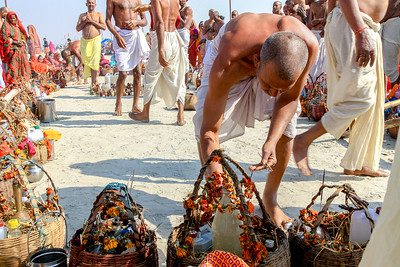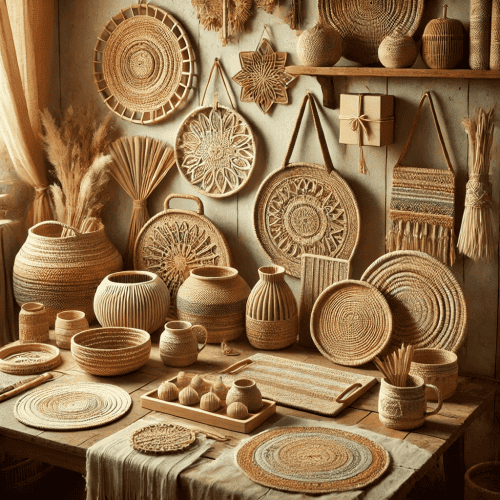Why settle for ordinary when you can add a touch of tradition to your home with these stunning Moonj baskets? Handcrafted from wild grass, these beauties are eco-friendly, vibrant, and packed with heritage. Perfect for storing your stuff and saving the planet, one weave at a time!

Moonj Baskets, made from sustainable moonj grass, showcase traditional craftsmanship, its versatile uses and the techniques behind this unique art.
Basketmaking is a cherished handicraft in India, deeply rooted in the country’s cultural heritage. Artisans across various regions skillfully weave baskets using materials such as bamboo, cane, grass, and palm leaves, each technique reflecting local traditions and artistic expressions.
These handcrafted baskets serve a multitude of purposes: they are essential for carrying goods, storing items, and even playing a role in rituals and festivals. In various Indian festivals, moonj baskets are used for ceremonial purposes, such as carrying offerings to deities or serving food during community gatherings. Their aesthetic appeal makes them a popular choice for festive decorations. In rural areas, baskets are vital for agricultural tasks, helping transport harvested crops efficiently.
They often transform into decorative pieces that enhance home aesthetics in urban settings. The intricate designs and functional versatility of these baskets not only support local economies but also preserve age-old craftsmanship, making basket-making a vital aspect of India’s artisanal landscape.

Among the various types of baskets, moonj baskets stand out for their use of moonj grass, a resilient and eco-friendly material. These baskets, known for their durability and aesthetic appeal, are commonly used in homes and for traditional purposes, showcasing the blend of functionality and artistry in Indian basket making.
The Moonj basket handicraft is an ancient, eco-friendly weaving tradition that exemplifies the harmonious relationship between nature and craftsmanship. Primarily crafted by rural artisans in Uttar Pradesh, particularly in regions like Allahabad, Varanasi, and surrounding villages.
Made from a natural fibre that is both durable and sustainable, this traditional craft has deep roots in Indian culture, reflecting the resourcefulness of local communities and their commitment to utilizing available materials in environmentally conscious ways.

In Indian craft traditions, Moonj baskets hold a significant place, symbolizing not just functional artistry but also the skills passed down through generations. Today, they are increasingly relevant in contemporary sustainable fashion and home decor, appealing to a growing audience that values eco-friendly products.
The significance of Moonj baskets extends beyond their practical use; they are integral to daily life in local communities, often used for storage, carrying goods, and even as decorative elements that add a touch of rustic charm to homes. As we explore the intricacies of Moonj basket making, we uncover a rich heritage that continues to thrive, bridging traditional practices with modern sensibilities.
Origin of an ancient handicraft – moonj grass weaving
The technique of basket crafting is an ancient tradition practised by Indians for various purposes. The people have demonstrated remarkable adaptability, utilizing the abundant resources nature provides. The craft of weaving baskets is almost as ancient as the skill of making ceramics. Reeds were woven together to create baskets that the old nomadic food gatherers used to store their food and other items that they gathered.
Later on, with the development of a variety of civilizations, the art of making baskets for both everyday use and ceremonial reasons began to take form. According to the customs and practices of the local community, unique designs have developed. Although the method that goes into making these items hasn’t changed much over the years, natural colours are now being utilised to make them seem more appealing.

Allahabad region’s fertile land supports the growth of a wide variety of plants and weeds, with bamboo being particularly abundant. Located near the banks of the Yamuna River in Allahabad, the village of Naini stands out as a major hub for the production of Moonj wild grass products. Moonj and Kaasa, two types of wild grass, flourish along the riverbanks in the vast areas surrounding Allahabad. In addition to basket weaving, the area is also known for its thriving production of bamboo and cane products, which are sold in large quantities.
How are moonj baskets made?
Moonj basketry can be found in nearly all local marketplaces throughout contemporary Prayagraj or Allahabad, where it is highly sought after by both residents and visitors. The wild grasses known as moonj and rara thrive along the banks of the rivers surrounding Allahabad. Moonj refers to the outer layer of the grass, which is scraped off and twisted together. Initially, the “Sarpat” grass appears lush and green.
After being harvested, the skin is removed, and the strands are tied into knots, referred to locally as “balla of the moonj.” This coiled grass is then dried in the sun, a process that requires careful monitoring; if it dries too much, it becomes difficult to bend during weaving. To create intricate designs, some of the coiled grass is dyed using boiling water, resulting in a variety of colours.

The colour of the grass is achieved with the use of dye. The grass is dyed with hues derived from the kaccha rang-raw plant. In a container made of metal, water is brought to a boil at an elevated temperature, and then the colour powder is added to it. For the dried, off-white Moonj grass to absorb the colour, it is submerged in a boiling solution.
Salt is added to the boiling liquid during the dying process because it allows the colour to last for a longer period after it has been applied. When the grass has reached the desired colour, it is cut down and left to dry in the shade. After being dried, this coil is first submerged in cold water, and then the weaving process may begin. Twigs are twisted into coils, and then the baskets themselves are constructed.
Often, the twigs are dyed to create designs. At the very end, softer grass, also known as kaasa grass, is used for retouching. The final products are jars, pots, trays, and baskets that are capable of holding a certain amount of weight while also being sturdy and long-lasting.
Traditional uses of moonj baskets
The skill of basket weaving is put to use for routine tasks. The Moonj basketry skill has mainly been in the spotlight because of the significant participation of rural women in its production. The most important reason for weaving these baskets is so that they may be put to use in the kitchen to put away food. The flour and other food grains are stored in the baskets, which are used in the kitchen. When food, particularly rotis, a kind of flatbread is kept in them, it does not become stale.
The simpler and more compact baskets are the ones that are intended for day-to-day usage. In contrast to the other villages, where it is only practised as a hobby, basket weaving provides a means of subsistence for its practitioners in Allahabad. It is possible to recognise the Tharus of Behraich baskets by their daring shapes and the sculpted animal and human patterns that they often include.
Maunis are circular baskets with broad openings and convex bottoms that are arranged in a row for the bride to walk in as she leaves her house in Gorakhpur. The ladies of Gorakhpur coil enormous maunis with beautiful patterns and lay them out in a row.
In some parts of Uttar Pradesh, the mothers of the brides make these baskets by hand as a wedding gift for their daughters. For the wedding of her daughter, a mother would craft one-of-a-kind baskets embellished with shell tassels. Some circular baskets or maunis are given to the bride to take with her, and it is loaded with sweets, grain products, and other presents.
Trending Moonj grass products popular in Handicraft stores
In today’s handicraft stores, a variety of moonj grass products are catching the eye of eco-conscious shoppers. Some of the most popular items include intricately woven baskets, storage boxes, and trays, perfect for organizing and adding a natural touch to homes.
Additionally, moonj grass is being used to create stylish coasters, placemats, planters, and decorative wall hangings. ‘Moonj grass laundry basket organic’ are terms increasingly googled for modern, sustainable options. These products are not only beautiful but are helping consumers embrace a greener lifestyle, replacing plastic and synthetic alternatives with eco-friendly, biodegradable choices. The rising demand for moonj grass crafts reflects a growing trend toward sustainable living and artisanal craftsmanship.
Where to buy moonj baskets
These baskets can be easily purchased at several local markets in Prayagraj (Allahabad), where artisans display their craftsmanship. Notable places in Allahabad include Chowk Market, known for its vibrant atmosphere and diverse selection of handicrafts, and Katra Market, which offers a range of traditional goods alongside Moonj products.
Civil Lines Market in Allahabad is another popular spot, featuring shops that specialize in eco-friendly items, including Moonj baskets. Shoppers can also explore seasonal craft fairs held throughout the year, where various artisans gather to showcase their work. For those who prefer online shopping, Moonj baskets are also readily available through various e-commerce platforms.
FAQ’s on Moonj baskets:
- What is Moonj grass otherwise known as, and where is it found? Moonj (Baadh)refers to the outer layer of Sarpat grass, scientifically known as Saccharum Munja. It is commonly found in desert regions and along riverbanks in northern India.
- What are moonj baskets made from? Moonj baskets are made from the fibres of moonj grass and kaansa grass, which are natural, eco-friendly materials.
- How are moonj baskets made? Moonj baskets are handwoven by twisting and coiling the grass fibres together. The artisans dye the fibres in vibrant colours and create intricate patterns during the weaving process.
- Where can I buy authentic moonj baskets? Authentic moonj baskets can be purchased from local markets in regions like Uttar Pradesh, India, or from online platforms that promote traditional handicrafts.
- What are the uses of moonj baskets? Moonj baskets are used for storage, carrying goods, and as decorative pieces. They are also popular as eco-friendly gift packaging or picnic baskets.
Read more: Latest



